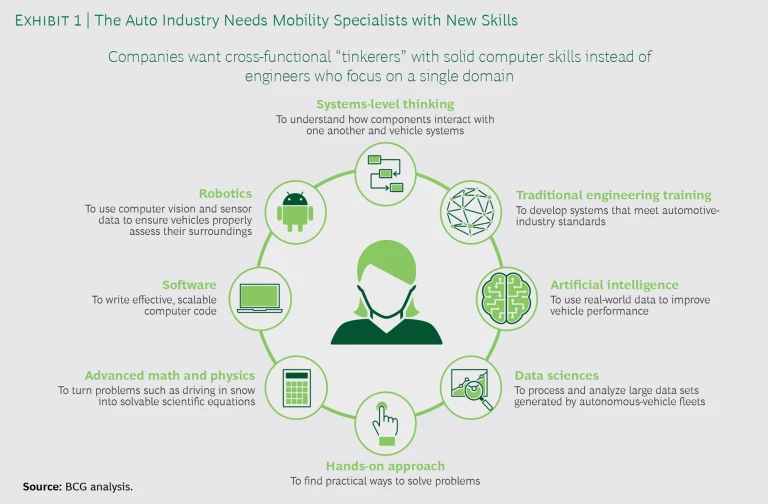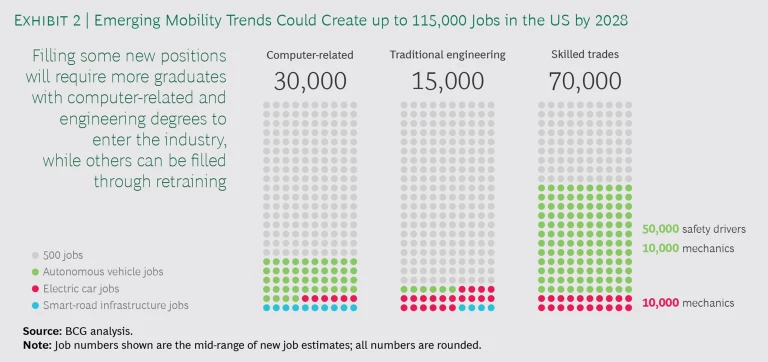The US automotive industry and tech companies continue to pour billions of dollars into research and development to build next-generation vehicles and related mobility services. At the same time, they face a burgeoning need for people with new skills. Just as the dawn of the jet-airplane era created positions for aeronautical engineers, the changes happening in the auto business are creating jobs for mobility engineers.
The US industry will need up to 115,000 new people in the coming decade, including 45,000 mobility engineers with computer-related and cross-domain skills, according to research from BCG and the Michigan Mobility Institute. We estimate that mobility companies will also need 70,000 skilled trades workers to test and maintain autonomous and electric vehicles (AVs and EVs). Finding such people won’t be easy; automakers, suppliers, and mobility players already grapple with a significant talent shortage as they compete with technology companies for highly skilled workers. What’s more, the demand for mobility engineers could be as much as six times higher than the expected supply, given the automotive industry’s historical share of such talent.
The US mobility industry will need up to 115,000 new people in the coming decade, including 45,000 mobility engineers with computer-related and cross-domain skills.
To get the talent they need, companies will have to step up recruiting and assess who in their current workforce can be retrained to gain new skills. They must offer that training or collaborate with educators to develop it. Instead of waiting for talent to come to them, companies may need to go where the talent is, establishing a presence in places that have become early mobility industry innovators, such as Boston, Pittsburgh, and Silicon Valley. For historical auto industry hubs, such as Detroit, to remain competitive, local governments and auto companies based there will have to ensure that the region’s educational institutions offer relevant programs.
New Cars and Mobility Services Require a New Workforce
People’s relationships with cars are changing. More consumers want transportation options that are fuel efficient and earth friendly. The popularity of ride-sharing services such as Uber and Lyft proves that people want options for getting around that don’t involve owning a car. But society’s changing attitudes aren’t the only things roiling the industry; powerful technological and regulatory forces will continue to lead to unprecedented transformation.
In the coming decades, these trends will manifest themselves in several ways. By 2030, electric vehicles will constitute half of all US new car sales . Mobility services such as self-driving cars and taxis are expected to make up another 10% of new cars on the road by that time as well. Shared mobility services, including on-demand ride-sharing and services that let people use a car on a subscription basis, are forecast to increase from 3% of global on-road passenger miles in 2017 to 9% in 2030. From 2025 on, many of the vehicles available through shared mobility services will likely be autonomous.
As cars evolve and mobility services mature, automakers will need engineers with new skills to develop and produce the vehicles. (See Exhibit 1.) Historically, car makers prioritized hiring engineers who specialized in a single domain—mechanical, industrial, electrical, or software engineering, for example. But that was before vehicles included more features that run on multiple components, such as advanced driver assistance systems (ADAS). Those functions will become even more commonplace in autonomous and electric vehicles. For example, engineers working on lidar, the light-based sensors that let self-driving cars map and navigate their surroundings, must know about optics and physics to understand how the sensors operate. They also need programming, artificial intelligence (AI), and other skills to make sure that lidar sensors work.
As a result, automakers want engineers with a strong foundation in multiple disciplines, including mathematics and physics; AI and machine learning; robotics; data sciences; software; and systems-level thinking. That requires hiring more cross-functional “tinkerers” who are comfortable doing hands-on work.
In addition, new types of engines and cars will require trade workers with the appropriate skills to build and maintain them. For example, to maintain self-driving and electric cars, mechanics need more electronic, electrical, and computer skills—including training on high-voltage repair and sensor calibration—than they did when cars were predominantly mechanical.
Mobility Trends Could Create 115,000 Jobs
Building a future in which autonomous and electric cars are ubiquitous could create up to 115,000 additional US automotive and mobility industry jobs in the coming decade. BCG research shows that 45,000 of these new jobs will be for mobility engineers, including 30,000 for graduates with computer-related degrees and 15,000 for graduates with traditional engineering training. (See Exhibit 2.)
The remaining 70,000 new jobs will be for skilled trades workers, including safety drivers (who ride in the cars to test them in real-world environments) and mechanics for AVs and EVs.
Today, less than 1% of college graduates with computer engineering, computer science, or software engineering degrees enter the auto industry, according to the US Bureau of Labor Statistics. We predict that the 30,000 new computer-related positions required by automakers in the next ten years will be about six times the number of graduates with similar degrees who are likely to enter the automotive industry. Of the total number, 22,000 computer scientists will be needed to work on AV technology.
Today, less than 1% of college graduates with computer engineering, computer science, or software engineering degrees enter the auto industry. About six times as many will soon be needed.
Of the mobility engineers needed, some will also work on nondigital technology, such as battery cells for electric cars. In the next decade, automakers will need 8,000 engineers just to develop and build such vehicles. Car companies will need another 5,000 engineers to build autonomous vehicles, and an additional 2,000 engineers to help construct smart-road infrastructure. In addition to mobility engineers, automakers will need 50,000 AV safety drivers by 2028.
Although the industry has enough mechanics today, their expertise is primarily in working on internal combustion engine powertrains and simple electronics. In the future, car companies will need 10,000 EV mechanics who understand enough about high-voltage and battery technology to work on EV powertrains. Companies will need another 10,000 mechanics with enough training on AV technology to calibrate sensors, repair robotic parts, test AV equipment, and perform related tasks.
We also anticipate that auto companies will hire people for other positions in the skilled trades, including remote AV support and fleet management, in addition to safety drivers and mechanics.
The importance of these new jobs and skill sets is underscored by the amounts that automakers have paid to buy mobility-industry startups. Not only have deals with high dollar amounts given established automakers access to new technology and faster times to market, they’ve also secured talent with the necessary mobility engineering skills.
In 2017, when Ford invested $1 billion in Argo AI, the startup’s workforce numbered around 200. The previous year, GM reportedly paid more than $500 million to buy the AV startup Cruise, which at the time had only 40 employees.
Mobility Engineers Need a Combination of Broad and Specialized Skills
Mobility engineers need a range of skills in areas that include data sciences, AI and machine learning, and software-programming languages for multiple emerging technologies. Other required skills vary depending on the technology involved. For example, mobility engineers who design and build self-driving cars must understand AV robotics; the ones working on EVs need a foundation in high-voltage systems; and those building smart-infrastructure projects need an understanding of urban engineering principles.
Engineers may need further specialized skills as well, depending on which part of the value chain they work in. In addition to expertise in electrochemistry, for example, an engineer working on EV battery design needs familiarity with mechanical-design optimization, electrical power nodes, control sensor technology, nickel–metal hydride and lithium-ion batteries, and cell design. Similarly, an engineer involved in EV architecture assembly needs a firm grasp of high-voltage electrical systems, schematic capture tools, circuit board and microcontroller design, and a half-dozen other electronics-related functions.
How to Attract Needed Talent
The demand for auto industry talent with the right skills isn’t new—car companies have had to address it for some time. As a result, they already locate offices close to talent hubs, fund university research, and acquire startups as much for their human capital as for other assets. But as automakers devote more of their efforts to new technologies, they need to take steps to create a whole new mobility industry workforce.
As automakers devote more of their efforts to new technologies, they need to take steps to create a whole new mobility industry workforce.
Companies. Automakers must help create the profession, including by supporting education and training programs. If companies have existing relationships with higher-education institutions, they can help the schools define curriculum for mobility engineering studies, including undergraduate, graduate, postgraduate, or certification programs. Companies can also support local institutes’ efforts to attract and retain potential students by offering internships, apprenticeships, and other opportunities for hands-on training.
Companies should also expand existing training or reskilling programs to include the skills outlined above for people working on AVs, EVs, and smart roads. One effective type of retraining program is a long-term apprenticeship, in which someone who is being reskilled or upskilled works one-on-one for several months with an engineer who has the desired skills and can teach what they know. Another is to have employees who are being reskilled take classes for half the day and spend the other half on the job, putting what they learn into practice.
Educational Institutions. Educators must partner with the industry to define what mobility engineering looks like and what skilled trades certification curriculums are needed in their area. They can use that feedback to create relevant undergraduate, graduate, and other programs. Because automakers want to hire mobility engineers with practical experience, educational institutions should build hands-on training into programs at all levels, including partnering with auto companies on labs, internships, apprenticeships, and work-study programs. They should also consider offering online, nighttime, weekend, or accelerated retraining programs for working professionals who need to learn new skills but cannot go to school full-time.
Cities and States. If they are serious about creating or expanding as mobility hubs to boost the local economy, cities and states must be willing to become the main orchestrators of the environments they want to create. They must collaborate with academic institutions to support educational and training programs. They must be open to working with companies that are looking for incentives, such as tax breaks, to move into the area, and help companies navigate regulations governing testing, safety, certifications, and AV operations. They should also clear the way for the creation of testing grounds where car companies can try out new vehicles. (See the sidebar “It’s Detroit’s Chance to Become the Center of the New Mobility Industry.”) Finally, they must offer the social, cultural, and recreational amenities that prospective students and people with in-demand skills want in the area where they work and live.
IT’S DETROIT’S CHANCE TO BECOME THE CENTER OF THE NEW MOBILITY INDUSTRY
IT’S DETROIT’S CHANCE TO BECOME THE CENTER OF THE NEW MOBILITY INDUSTRY
To attract the next generation of automotive and mobility industry workers, Detroit can’t rest on its laurels. The auto industry’s historical hub must take steps to train, attract, and retain mobility engineers and technicians or risk losing them to other parts of the country where startups have appeared near universities that conduct relevant research.
The Detroit metro area is still the US auto industry’s focal point. The area is home to 17 automakers and 62 auto suppliers, and accounts for 76% of the US auto industry’s research and development. These factors, along with the area’s history of innovation and access to engineering talent, position the city to remain a global mobility hub.
However, R&D for AVs and EVs conducted at universities in other regions have turned the areas around those campuses into mobility magnets, making them attractive to current engineering talent with in-demand skills. For example, the global technology and auto parts company Aptiv has offices in Boston near the Massachusetts Institute of Technology; Argo AI and Uber both started in Pittsburgh near Carnegie Mellon University. Many auto companies have offices in Silicon Valley near Stanford University, including Cruise and Waymo.
Detroit has already made some moves to stay relevant. The area supports AV test facilities run by the American Center for Mobility and the University of Michigan’s Mcity. The city also convinced Ford to commit to turning a former railroad station in downtown Detroit into a 1.2 million square-foot hub for smart-vehicle innovation.
The city must focus on producing more mobility engineers and skilled trades professionals as well. It should partner with companies and academic institutions in the area to define their exact needs and then develop programs aimed at both students and professionals.
The automotive and mobility industry is in the middle of its biggest revolution in decades. But the changes can’t happen without a revolution in workers’ skills. To turn goals into reality, companies, educational institutions, and local governments must act individually and together to attract and develop the workforce they need.








